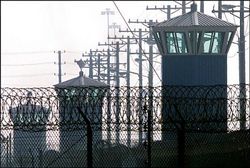How does the biggest prison strike in American history go unnoticed?
 By Mark Anthony Neal, TheLoop21.com
By Mark Anthony Neal, TheLoop21.comIn September of 1971, more than a thousand prisoners at the Attica Correctional Facility in Attica, NY revolted in what eventually became one of the most famous prison standoffs in American history. Before the insurrection was bloodily quelled on orders of then New York State Governor Nelson Rockefeller, the prisoners demanded an improvement to the conditions that they were forced to live. In the midst of the Black Power Movement, Attica became a lasting symbol for demands for human and civil rights, even among the incarcerated.
In the spirit of Attica, nearly 40 years later, prisoners at six prisons in Georgia organized a non-violent labor strike to demand better conditions for themselves. Specifically the inmates demanded a living wage for their work, educational opportunities, decent health care, an end to cruel and unusual punishment, decent living conditions, nutritional meals, opportunities for self-improvement (rehabilitation), access to their families and just parole decisions.
Perhaps even more remarkable than the strike, in which inmates shared information via text messaging on phones bought from prison guards, is that the strike went virtually unnoticed by mainstream American media. That so many chose to ignore what has been called the largest strike of its nature in American history, speak volumes to how Americans continue to think of the American Prison System or what scholars and activists have more commonly referred to as the "Prison Industrial Complex." The inmates themselves have another word for their reality: "Slavery."Prisons are big business in the U.S., which has the largest prison population in the world, as Boyce Watkins recently noted. Mirroring the convict leasing programs of the late 19th and early 20th century, where prisoners were leased as laborers to third parties, the Prison Industrial Complex is simple a new term for old practices. Even when states outlawed convict leasing, some states built prisons with the idea of generating income from within. The infamous Mississippi State Prison, also known as Parchman Farm -- referenced throughout August Wilson's The Piano Lesson -- is but one example of this phenomenon.
Currently American prisoners are used as laborers to do jobs ranging from cleaning highways, to making furniture for federal agencies, moving library books at state universities to any number of jobs that generate profits for other institutions, while paying the inmates on average 40 cents a day, if they are paid at all. Even better than hiring temporary employees, the Prison Industrial Complex allows companies the opportunity to "hire" workers on the lowest end of the wage scale, without having to worry about health insurance, sick-days or vacation time.
In the backdrop of these practices is the fact that the building and privatization of prisons is one of the country's biggest growth industries, not only generating profits for those who build and own prisons but creating jobs in communities suffering from economic decline. One well-known example of this was the growth of prisons in New York State in the 1990s, many of them located in largely white rural towns.
Of course you can only have prison growth by having an increase of prisoners -- according to the Sentencing Project there has been a 500% percent increase in the number of Americans incarcerated since 1980 -- and that was achieved in New York State via the Rockefeller Drug Laws, named after the same governor responsible for the bloodshed at Attica, which increased the prison population with non-violent drug offenders. "Three Strikes" offenses had the same impact nationally.
The key to expanding prisons is to criminalize behavior that could be best treated medically or psychologically, like drug addiction. In the big business of American prisons, criminalizing "blackness" seems a critical component, with television shows like "Oz" and "The Wire" (despite all its complexity) and social panics over "sagging" helping to desensitize the American public to the realities of prison life.
With so many people benefiting economically and politically from the Prison Industrial Complex, it's no surprise that mainstream media turned a deaf ear and a blind eye to the Georgia Prison Strike. In a society that has little regard for inmates or their rehabilitation, and a fundamental belief that that prisons only stockpile Black and Latino men who are innately criminal, we can expect little empathy for the fact that most prisoners, even if they are not living inhumane conditions, are being economically exploited in ways that are apropos to chattel slavery.
Yet, American media must be held accountable for highlighting stories that shed light on the kind of inequities. Too often the bottom line for corporate media is covering the fact that famous people are sent to jail -- think about coverage of Michael Vick and Paris Hilton as examples -- and not what happens to everyday American citizens when they are in jail.
Mainstream media's failure to cover this and many other stories only highlights the importance of independent and Black-owned independent media like Democracy Now, where host Amy Goodman interviewed former Black Panther leader and inmate advocate Elaine Brown very early during the strike, and Black Agenda Report, which published daily updates on the strike. [Editor's note: Facing South also covered the strike here.] With much news reporting and even editorial content being dictated by economic bottom lines, it's important that we all become vigilant in our support of independent media, who are interested in telling stories that matter, not stories that will generate profits.
Mark Anthony Neal is the author of five books, including the forthcoming Looking for Leroy. He teaches Black Popular Culture in the Department of African and African-American Studies at Duke University in Durham, N.C. Email Mark at mark@theloop21.com. Follow him on Twitter @NewBlackMan.